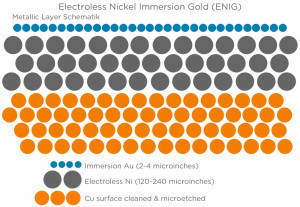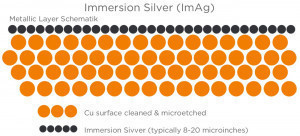With this key sentence, Alexandre Dumas père elegantly eliminated the competition between his musketeers - who rarely appear with muskets, but often with swords in countless films. After all, who can really say who is the 'best'? Doesn't it depend on several criteria? The best marksman is usually not the best rapier fencer or the most successful with attractive ladies (they are never missing from the relevant literature or films). It is the same with other decisions where other interests are also involved. Take, for example, the long-running competition between the numerous end surfaces for printed circuit boards. Here, the opinions and propaganda experts of the companies are as heated as in the press or politics.
But let's start at the beginning. End surfaces were introduced to ensure the solderability of the sensitive copper layer even during longer storage periods. However, as is so often the case, there are often unforeseen 'side effects' that can have both positive and negative effects.
This starts with storage, for example, where reactions can occur. The polymerization of rosin varnishes has become notorious. Others have difficulties with paste printing if the surfaces are uneven. It continues with the assembly and finally, quite significant differences have been found in the durability of the solder joints.
There is also an interaction between the alloys in the paste and the reflow profile, as components occasionally slide off in the reflow oven.
 Reflow soldering oven for the assembly of printed circuit boards
Reflow soldering oven for the assembly of printed circuit boards
Although the quality usually depends on the costs (per square meter of PCB), the end result should ultimately also be taken into account, because the different products produce errors - some significantly more than others and errors can be costly.
In the meantime, health effects [2] are also taken into account during production, as some companies are actually concerned about their employees - the scare word 'carcinogenic'. The environment is also taken into account, at least by those who buy 'organic'.
Rare metals and other rare chemicals are being eyed, not least because politicians are interested in their origin from conflict zones.
How much energy is used to apply such a layer? In other words, do we need another wind farm?
The user may be interested in whether the coating could be refreshed at low cost if the solderability is reduced after too long storage and despite all the promises. This is particularly doubtful in the case of coatings that are already attacking the copper ('undercut') or depositing.
On the other hand, today's products often undergo a number of thermal excursions. Can the surface cope with this so that 'solderability' can still be expected even with selective soldering or the occasional repair that is certainly necessary?
Some end surfaces are more sensitive and inert atmospheres are required - another cost factor and more energy consumption to produce the fairly pure nitrogen.
What about handling? Is it safe to touch the surface with dirty paws? This is often less of a problem with those that melt than with others - although it is of course not advisable in all cases. Perhaps you also have to use certain fluxes? This then further limits the scope and may have an effect on cleanliness and the washing cycle that may be required.
The pitch is getting finer and finer and some end surfaces have their problems with this. For example, hot air tinning requires thinner layers, which goes against the basic idea of the protective layer. The process engineer also needs to find out whether the supplier is using a horizontal or vertical process, as they differ in terms of the end result.
In any case, there are significant differences between the various suppliers [3], as studies have repeatedly shown. The buyer who always goes for the cheapest can be very expensive for the company, because poor quality leads to many process errors, which are extremely costly to repair, which is not to say that the cheapest is always the worst.
Something that reads as 'aspect ratio' is becoming increasingly popular in relevant discussions. This refers to the ratio of the clear width of the thinnest hole to the thickness of the PCB. It turns out that the thicker the PCB and the thinner the hole, the more difficult - i.e. more expensive - it is to obtain a good and qualitatively uniform final surface.
The process engineer may also not know that some of the processes are patented and therefore justify a surcharge. The patent holder sells his own machines and chemicals and thus earns several times over. The PCB manufacturer must therefore decide which patent he wants to use, because often several comparable processes are patented. And perhaps the success of one patent does not depend as much on quality as on the skill of the patent holder's salesmen? Poor process engineer!
Legislation is also interfering and so we now have to ask ourselves whether the final surface to be selected complies with RoHS or whether conflict minerals may be used. Some metals and rare earths come from the Congo etc., which does not have the best reputation when it comes to human rights and child labor. This perhaps bothers politicians less than the rebels who use it to finance their arms purchases.
Some of the more modern finishes, which sound promising, are still produced by very few suppliers. This has an impact on prices and availability. As a result, a lot of key data is still missing for them, which only emerges once the product has been used by various companies for a longer period of time and results from the field have been analyzed, so that it is not necessary to rely solely on possibly questionable test results.
Finally, the quality supervisor gets in touch and wants to know how to inspect the incoming PCBs. If the final surface is thin [4] and even allows the color of the copper to shine through, you can hardly recommend the inspection with an oblique glance.
Oh yes, and there is also something like a needle bed tester.
Does the end surface make it difficult to place the tips or make contact?
As a solderer, you concentrate on soldering and ask the right questions. The world may not be getting better, but it is getting more complicated. That's why you occasionally have to look beyond the edge of the soup bowl - perhaps just to see who's leading the charge.
As you can then see, other processes are also influenced by the final surface. Wire bonding, with which the bare chips are transferred to the circuit board, is now at the top of the list. There are also several methods with different materials, and these should also harmonize with the selected end surface. As an alternative, two end surfaces are used to 'selectively' protect zones of the PCB, as some companies, not only in Japan, are doing: one for soldering, the other for wire bonding.
A further development in products may be related to this. Cell phones and other communications are being upgraded from the current frequency to 5G. This means that surface properties at high frequency are another parameter to consider. Due to conductivity[5] and also depending on the thickness (at higher frequencies, the dependence on the end surface is more critical due to the skin effect), 'losses' occur.
Connectors are now an additional problem because they have to be routed to contact surfaces. If the end surface is insulating, you either choose another one that has better properties because of this, or you have to keep the end surface away from these contact surfaces and perhaps apply something else - gold?
With this barrage of objections, it is hardly surprising that groups or clubs such as the IPC[6] are repeatedly making a stand and carrying out comparative analyses. They take a 'sample circuit board', which is usually designed according to their own interests, and check a few of the parameters mentioned in order to then select not the 'best' final surface, like a carnival princess, but at least a self-chosen optimum.
With the composition of the committees ("... interested industry participants composed of suppliers, manufacturers, assembly houses and end users ...") and the complicated procedure ("If there is consensus then the committee documents it in a specification. In cases where no consensus is readily arrived at, the committee undergoes its own testing in what is commonly referred to as a 'Round Robin' (RR) study"), one may doubt pure objectivity, because experience has shown that the suppliers have usually shown more 'interest' than the users and so such committees are often somewhat one-sided. This is another reason why every specification lags years behind the current status.
 A somewhat brief comparison table - some specifications should be taken with a spoonful of salt
A somewhat brief comparison table - some specifications should be taken with a spoonful of salt
Since the founding of the 'IPC Plating Sub-committee 4-14', the following specifications have been published - although you should pay attention to the year:
|
IPC-4552 |
ENIG |
Specification |
2002 |
||
|
IPC-4552 |
ENIG |
Specification |
Amended |
2012 |
|
|
IPC-4553 |
Immersion |
Silver |
Specification |
2005 |
|
|
IPC-4554 |
Immersion |
Tin |
Specification |
2007 |
|
|
IPC-4553A |
Revised |
Immersion |
Silver |
Specification |
2009 |
|
IPC-4552 |
Amended |
ENIG |
Specification |
2011 |
|
|
IPC-4554 |
Amended |
Tin |
Specification |
2011 |
|
|
IPC-4555 ENEPIG |
specification |
2013 |
It is perhaps also noticeable that (with the exception of tin) the cheaper and quite efficient end surfaces do not appear, which perhaps reflects the 'interest' of the committee and its members. Less surprisingly, however, the newest - including nanosurfaces - are not listed.
Image sources
References
[1] As a motto in Switzerland, also French ("un pour tous, tous pour un"), Italian ("Uno per tutti, tutti per uno") and Romansh ("In per tuts, tuts per in") - and of course from 'Les Trois Mousquetaires by Alexandre Dumas père', first edition 1844.
[2] Dow Electronic Materials; Cleaning Up PCB Final Finish: Cyanide-Free ENIG Coatings; May/4, 2017 or the use of thiourea (carcinogenic) in immersion tin.
[3] Allan Wilcox, 'White Tin, Why Are You Black?
[4] OSP: 100-4000 Ångströms.
[5] Gold: 4.52 × 107 S/m, copper: 5.817 × 107 S/m. Silver: 6.301 × 107 S/m.
[6] George Milad, 'Final Finish Specifications Review IPC Plating Sub-committee 4-14', IPC APEX EXPO Conference Proceedings.

![Column: Viewed differently - One for all, all for one [1]](/images/2024/06/18/b91965fca2fe5021753939983c8e2b1d_large.jpg)






